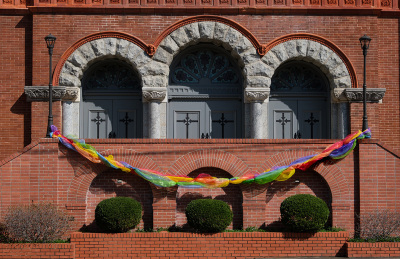Death by bologna sandwich

The United Methodist minister of a large church in Dallas two days ago shared a long Facebook “dream” in which he imagined I choked to death while eating a bologna sandwich and chortling over my denominational mischief. I’m then standing before St. Peter and confronted by my reputed sins, which included working for the CIA, fighting “commies” in the Church, and supposedly trying to keep gays out of the Church. At the end, St. Peter tells me, “John Wesley wants to talk, and just a warning he’s pissed.”
This minister’s post was overly long, especially for a “dream,” not clever or funny, and tacky. The minister had concluded it by saying he “prayed to rewind the dream tonight and I’ll report to you what happens to you if it comes to me.” But he removed the post last night, so maybe he will not report further about his “dreams.”
The incident recalled another moment involving a United Methodist official and sandwiches. In 2015 Board of Church and Society Director of Civil and Human Rights, Bill Mefford, tweeted a sarcastic photo of himself among pro-life marchers by the U.S. Capitol with a sign proclaiming: “I March for Sandwiches.” His tweet further explained: “I was inspired by the march for life to march for what I believe in!” His tweet got publicity. Later he apologized and was not much longer on the agency staff.
Both of these Methodist sandwich incidents point to a common lack of seriousness among many United Methodist clergy that may be more generational than theological. When I grew up in the church in the 1970s and 1980s, our pastors included conservatives and liberals, but they were generally dignified, taking their office seriously. It’s hard to picture any of them performing sandwich incidents. The contemporary lack of seriousness is likely not confined to Methodist clergy.
This Dallas minister dreaming about my death was upset about my article in The Wall Street Journal regarding United Methodism’s ongoing division over sexuality and theology. He mocked my traditionalist views even though he was himself until recent years a traditionalist. He even wrote an admiring biography of the late Bill Hinson, the longtime Houston pastor who championed traditionalism and advocated United Methodist division in 2004.
The “dream” about my death by a United Methodist minister who identifies as not progressive but “centrist” also does not bode well for the toleration that “centrists” claim will protect traditionalists when United Methodism officially liberalizes its sexual teachings. If traditional views are as intrinsically hateful as “centrists,” not to mention progressives claim, then traditionalists of course should not be tolerated in the Church any more than racists. And of course, they will not be.
Many traditionalists are now exiting United Methodism with the realization that the declining denomination is unfixable. This mass exit will eventually allow “centrists” and progressives to overturn United Methodism’s traditional teachings about marriage. This prospect should fill clergy like this dreaming Dallas minister with joy, thanksgiving, and anticipation. Instead, he and many kindred clergy are angry and resentful. Apparently impending victory, after 50 years, is not as sweet as imagined.
“Centrist” and progressive clergy resent the presence of traditionalists in the church and they resent their departure. They know that, based on the example of other fast declining liberalized Mainline Protestant denominations, United Methodism’s over half-century of decline not only will continue indefinitely but accelerate. They know that the church’s vast bureaucracy, built in the 1960s for a USA denomination of 11 million, cannot be supported by the current church of 6 million, and certainly not by the soon-to-be church of 3 or 4 million, if not lower.
The United Methodist era of million-dollar agencies, guaranteed jobs for clergy, scores of bishops and tens of thousands of churches, and unaccountable seminaries, under a command and control structure, is ending. What will come next? Nobody knows but it will be difficult. The profits from the sale of thousands of closed churches are the only bright light for future United Methodism.
What will St. Peter and John Wesley say about the demise of United Methodism when, by God’s grace, we meet them? All of us have failed in many ways. But clergy who used their office to mock traditionalists with “dreams” or signs about sandwiches likely won’t draw many smiles of approval.
Originally published at Juicy Ecumenism.
Mark Tooley became president of the Institute on Religion and Democracy (IRD) in 2009. He joined IRD in 1994 to found its United Methodist committee (UMAction). He is also editor of IRD’s foreign policy and national security journal, Providence.




















